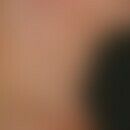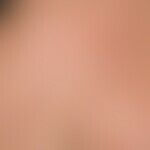Synonym(s)
DefinitionThis section has been translated automatically.
Rare, congenital or acquired variant of porokeratosis, with typical anular horn papules in linear or zosteriform arrangement (arrangement in the Blaschko lines).
EtiopathogenesisThis section has been translated automatically.
A cutaneous mosaicism (cutaneous mosaic) is assumed etiopathogenetically.
Type I: early somatic mutation in the keratinocytes.
Type II: present germline mutation. In addition, somatic mutations occur which lead to the loss of heterozygosity in the area concerned.
You might also be interested in
ManifestationThis section has been translated automatically.
ClinicThis section has been translated automatically.
Cutaneous mosaic dermatosis with linear, band-shaped, also circular or garland-shaped, or half-sided, (cases affecting an entire half of the body have been described), red or red-brown, sharply demarcated, keratotic papules and plaques. No significant subjective complaints. Apart from the very characteristic macro-pattern, the histological picture is diagnosis-defining.
2 variants can be distinguished clinically:
- Type I: exclusively unilateral linear or band-shaped affection.
- type II: generalized porokeratosis with additional blaschcoid structures (linear or swirled groupings)
HistologyThis section has been translated automatically.
Hyperkeratotic epidermal papules with parakeratotic horny lamella. Acanthosis, hyperkeratosis, flag-like parakeratosis (cornoid lamella). At the base of the parakeratosis, keratinocytes with pyknotic atypias and perinuclear edema appear.
Differential diagnosisThis section has been translated automatically.
ILVEN: Typical aspect of anular horn papules missing. Differential histology.
Lichen planus: Porokeratosis does not itch; the lichenoid aspect of the lichen planus is missing. Differential histology.
Porokeratotic eccrineostiumnaevus (Porokeratotic eccrine ostial and dermal duct nevus - PEODDN). Also in this case a cornoid lamella is formed, but over dilated eccrine sweat gland ducts.
Porokeratotic eccrine duct and hair follicle nevus (PEHFN). Formation of a cornoid lamella over dilated follicle ostia.
TherapyThis section has been translated automatically.
External therapyThis section has been translated automatically.
Operative therapieThis section has been translated automatically.
Progression/forecastThis section has been translated automatically.
Chronic course. Spontaneous healings are possible. Malignant degeneration not excluded.
LiteratureThis section has been translated automatically.
- Apel HP et al (1986) Porokeratosis linearis unilateralis (Linear porokeratosis). Dermatologist 37: 284-286
- Boente Md Mdel C et al (2003) Linear porokeratosis Associated with Disseminated Superficial Actinic Porokeratosis: A New Example of Type II Segmental Involvement. Pediatr Dermatol 20: 514-518
- Curnow P et al (2003) Multiple squamous cell carcinomas complicating linear porokeratosis. Australas J Dermatol 44: 136-139.
- Nazarian RS et al (2020) Linear porokeratosis presenting in adulthood: A diagnostic challenge: A case report. SAGE Open Med Case Rep 8:2050313X20919613.
- Sertzing P et al (2010) Congenital linear unilateral porokeratosis. JDDG 8:943-944
- Tseng SS et al (2002) Linear porokeratosis with underlying bony abnormalities. Cutis 69: 309-312
Incoming links (4)
Neviform porokeratosis; Porokeratosis mibelli zosteriformis; Porokeratosis zosteriformis; Tretinoin cream hydrophilic 0.025/0.05 or 0.1% (nrf 11.101.);Outgoing links (13)
Acanthosis; Blaschko lines; Cryosurgery; Excision; Heterozygosity; Ilven; Keratolytics; Laser; Lichen planus classic type; Papel; ... Show allDisclaimer
Please ask your physician for a reliable diagnosis. This website is only meant as a reference.









